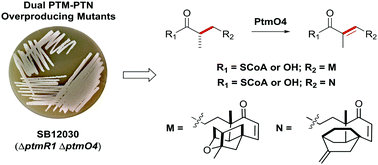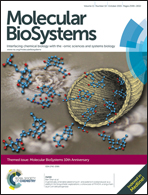A genetically amenable platensimycin- and platencin-overproducer as a platform for biosynthetic explorations: a showcase of PtmO4, a long-chain acyl-CoA dehydrogenase†
Abstract
Platensimycin (PTM) and platencin (PTN) are members of a new class of promising drug leads that target bacterial and mammalian fatty acid synthases. We previously cloned and sequenced the PTM and PTN gene clusters, discovered six additional PTM–PTN dual producing strains, and demonstrated the dramatic overproduction of PTM and PTN by inactivating the pathway-specific regulators ptmR1 or ptnR1 in five different strains. Our ability to utilize these PTM–PTN dual overproducing strains was limited by their lack of genetic amenability. Here we report the construction of Streptomyces platensis SB12029, a genetically amenable, in-frame ΔptmR1 dual PTM–PTN overproducing strain. To highlight the potential of this strain for future PTM and PTN biosynthetic studies, we created the ΔptmR1 ΔptmO4 double mutant S. platensis SB12030. Fourteen PTM and PTN congeners, ten of which were new, were isolated from SB12030, shedding new insights into PTM and PTN biosynthesis. PtmO4, a long-chain acyl-CoA dehydrogenase, is strongly implicated to catalyze β-oxidation of the diterpenoid intermediates into the PTM and PTN scaffolds. SB12029 sets the stage for future biosynthetic and bioengineering studies of the PTM and PTN family of natural products.

- This article is part of the themed collection: 10th Anniversary of Molecular BioSystems

 Please wait while we load your content...
Please wait while we load your content...